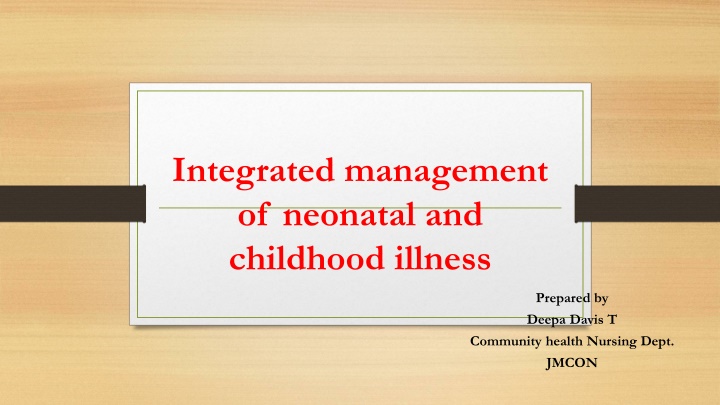
Childhood Illness Management Strategies: IMCI and IMNCI Overview
Discover the integrated management of neonatal and childhood illnesses with a focus on IMCI and IMNCI strategies. Learn about the objectives, components, and methodologies aimed at enhancing child health. Explore how these strategies promote evidence-based assessment, cost-effective treatment, and disease prevention.
Download Presentation

Please find below an Image/Link to download the presentation.
The content on the website is provided AS IS for your information and personal use only. It may not be sold, licensed, or shared on other websites without obtaining consent from the author. If you encounter any issues during the download, it is possible that the publisher has removed the file from their server.
You are allowed to download the files provided on this website for personal or commercial use, subject to the condition that they are used lawfully. All files are the property of their respective owners.
The content on the website is provided AS IS for your information and personal use only. It may not be sold, licensed, or shared on other websites without obtaining consent from the author.
E N D
Presentation Transcript
Integrated management of neonatal and childhood illness Prepared by Deepa Davis T Community health Nursing Dept. JMCON
Objectives Central objectives At the end of the class the Students will gain indepth knowledge regarding IMNCI and apply this knowledge in practice with positive attitude
Objectives Specific Objective Students will be able to Define IMNCI List down Objectives Explain the Stratergy with components Describe the Colour code Enlist the Elements of IMNCI Explain IMNCI process
IMCI IMCI is a strategy for an integrated approach to the management of childhood illness as it is important for child health programmes to look beyond the treatment of a single disease. It is cost effective and emphasizes prevention of disease and promotion of child health and development besides provision of standard case management of childhood illness.
IMNCI designed for the management of sick children aged 1 week up to 5 years. They promote evidence-based assessment and management, using a syndromic approach that supports the rational, effective and affordable use of drugs. They include methods for assessing signs that indicate severe disease; assessing a child's nutrition, immunization, and feeding; teaching parents how to care for a child at home; counselling parents to solve feeding problems; and advising parents about when to return to a health facility.
CONTD sick children present with signs and symptom related to more than one conditions. So we need a combine therapy In response to these challenge, WHO and UNICEF developed a strategy known as IMCI. The strategy combines improved management of childhood illness with aspects of nutrition, immunization, and other important disease prevention and health promotion elements
CONTD IMCI classifications are action oriented and allow a health care provider to determine if a child should be urgently referred to another health facility, if the child can be treated at the first-level facility (e.g. with oral antibiotic, antimalarial, ORS, etc.) or if the child can be safely managed at home.
objectives to reduce deaths and the frequency and severity of illness and disability to contribute to improved growth and development.
The strategy includes three main components Improvements in the case-management skills of health staff through the provision of locally adapted guidelines on IMCI and through activities to promote their use. Improvements in the health system required for effective management of childhood illness. Improvements in family and community practices.
CONTD IMNCI strategy is one of the main intervention under the RCH II/ NRHM The strategy encompasses a range of interventions to prevent and manage the commonest major childhood diseases. Pre-service IMNCI Facility based IMNCI (F-IMNCI) Facility based newborn care
Case Management Process The case management process is presented on two different sets of charts : one for children age 2 months up to five years, and one for children age 1 week up to 2 months.
ELEMENTS OF IMNCI a. Assess b. Classify -urgent pre-referral treatment and referral (pink), or - specific medical treatment and advice (yellow}, or - simple advice on home management (green). c. Identify d.Treatment e.Counsel f. Give follow-up care
The Indian version of IMCI has been renamed as Integrated Management of Neonatal and Childhood Illness (IMNCI) in 2003 It is the child health interventions under the RCH II strategy. The major highlights of the Indian adaptation are : a. Inclusion of 0-7 days age in the programme b. Incorporating national guidelines on malaria, anaemia, vitamin-A supplementation and immunization schedule c. Training of the health personnel begins with sick young infants upto 2 months d. Proportion of training time devoted to sick young infant and sick child is almost equal; and is skill based.
objective To implement IMNCI package at the level of household, and through ANMs at sub-centre level; through medical officers, nurse and LHVs at PHCs level
REFERENCE 1. Park k, Textbook of community medicine,25 thed, bhanot publishers,2020 2.Gullani KK,Community Health Nursing,2nded, kumar publishers,2012 3 .Kadri AM, Text book of Community Medicine,1STed,jaypee publishers,2019
